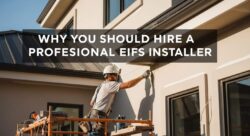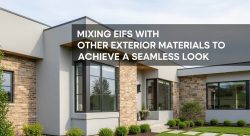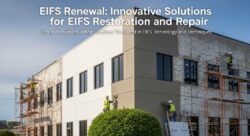Avoid Costly Damage with Proven EIFS Mounting Techniques
Key Takeaways
- Improper mounting on EIFS can lead to water damage, structural issues, and expensive repairs
- Special anchoring systems designed specifically for synthetic stucco are essential for secure attachments
- Proper sealing techniques are critical in Indiana’s freeze-thaw climate to prevent moisture infiltration
- Weight distribution must be carefully considered when adding fixtures to EIFS façades
- Professional installation by experienced EIFS contractors saves money and prevents damage long-term
Introduction: The Hidden Dangers of Improper EIFS Mounting
Ever drive past a beautiful stucco home with charming exterior lights or an elegant awning? They look fantastic, right? But here’s what you might not see – the water damage lurking beneath those fixtures. As the owner of Indiana Wall Systems with over 22 years in the EIFS business, I’ve seen far too many homeowners make costly mistakes when attaching items to their synthetic stucco exteriors.
The truth is, your EIFS (Exterior Insulation and Finish System) isn’t just a wall – it’s a carefully engineered building envelope system designed to keep water out while insulating your home. Every hole, screw, or mounting bracket creates a potential entry point for moisture if not done correctly.
And here in Indiana? Our freeze-thaw cycles make this even more critical. Water that seeps in during fall rains freezes in winter, expands, and creates bigger gaps that allow even more water in when spring arrives. Before you know it, you’ve got rotted sheathing, damaged framing, and a repair bill that makes that fancy new light fixture seem like small potatoes.
But don’t worry – you don’t have to choose between style and function. This guide will walk you through everything you need to know about safely mounting lights, awnings, address numbers, decorative elements, and more on your EIFS home.
Understanding What Makes EIFS Different from Traditional Siding
Before we dive into how to mount things properly, let’s talk about why EIFS requires special consideration in the first place.
The Layered Structure of EIFS
Unlike traditional siding materials like wood, vinyl, or fiber cement, EIFS is a multi-layered wall system. From the outside in, a typical EIFS wall consists of:
- Finish coat – The colored, textured outermost layer
- Base coat – A cement-based layer that provides durability
- Reinforcing mesh – Fiberglass mesh embedded in the base coat for strength
- Insulation board – Expanded polystyrene (EPS) foam providing the insulation value
- Adhesive – Secures the insulation to the substrate
- Water-resistive barrier – In newer systems, provides a drainage plane for any moisture
- Substrate – Typically OSB, plywood, or gypsum sheathing
- Structural framing – The wood or metal studs of your home
Each layer serves a specific purpose in the system, working together to create a weather-tight, energy-efficient envelope. When you drive a screw or nail through these layers, you’re potentially compromising this carefully designed system.
Why Traditional Fasteners Don’t Work Well with EIFS
Traditional mounting methods that work fine on wood or brick can spell disaster for EIFS. Here’s why:
- Foam insulation isn’t structural – The EPS foam layer can’t support weight the way solid wood or masonry can
- Penetrations create pathways for water – Any hole through the finish and base coats creates an opportunity for water entry
- Special considerations for the drainage plane – In newer EIFS with a drainage plane, improper penetrations can disrupt the water management system
- Thermal bridging concerns – Metal fasteners that extend from the exterior to the interior can conduct heat, reducing the insulation value
That beautiful new light fixture? It needs more than just a couple of screws to mount safely on EIFS. It needs a mounting strategy that accounts for all these factors.
Common EIFS Mounting Mistakes That Lead to Damage
In my two decades of EIFS repair work across central Indiana, I’ve seen the same mounting mistakes over and over. Let’s learn from others’ costly errors:
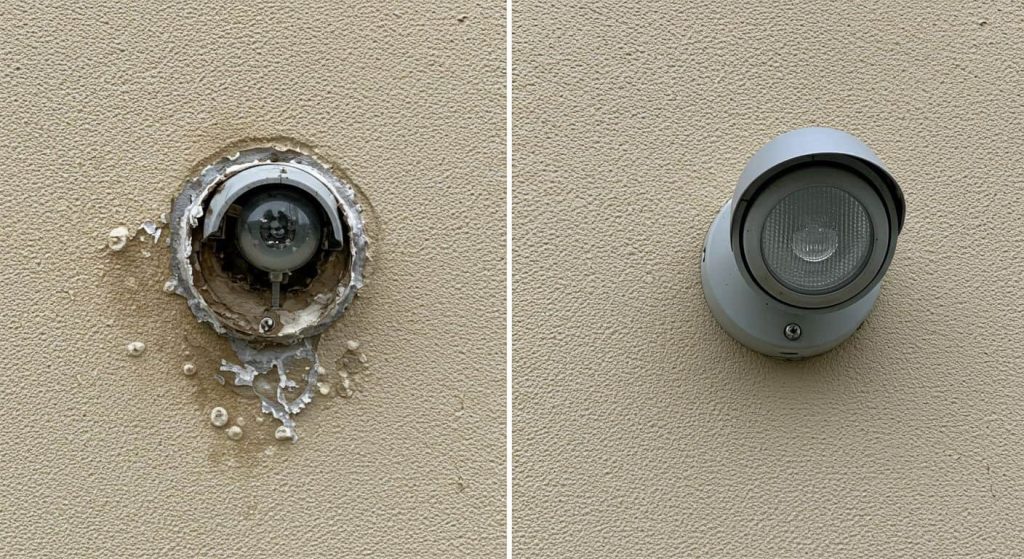
Mistake #1: Using Standard Drywall Anchors or Wood Screws
Probably the most common mistake I see is homeowners treating EIFS like it’s drywall or wood siding. They grab whatever anchors they have in the garage and start drilling. Standard drywall anchors, toggle bolts, and wood screws aren’t designed for EIFS applications and won’t distribute weight properly across the foam insulation.
Real-life example: Last year, we repaired an EIFS home in Carmel where the homeowner had mounted heavy address numbers using simple plastic anchors. Within six months, the numbers were sagging, pulling away from the wall, and water was seeping in behind them. The repair involved removing a 4×4 foot section of EIFS down to the sheathing, replacing water-damaged materials, and reinstalling new EIFS.
Mistake #2: Failing to Properly Seal Penetrations
Even with proper anchors, failing to seal around penetrations is asking for trouble. Every hole in your EIFS creates a potential water entry point. Without proper sealing, moisture will find its way in.
Real-life example: A client in Zionsville installed a beautiful array of uplighting around their home’s exterior but didn’t properly seal the electrical conduit penetrations. After just one season, water had infiltrated the system, causing the foam to deteriorate and the finish coat to delaminate. The repair cost was over ten times what proper sealing would have cost initially.
Mistake #3: Ignoring Weight Distribution Requirements
EIFS isn’t designed to support heavy items like large awnings or shutters without proper reinforcement. When too much weight is concentrated in one area, the system can fail, even with proper anchors.
Real-life example: We were called to a home in Fishers where a homeowner had installed a heavy metal awning over a patio door. They used anchors, but they weren’t sufficient for the weight. The awning eventually pulled away from the wall, taking chunks of the EIFS with it and allowing water to penetrate. The damage extended well beyond the mounting points.
Mistake #4: DIY Installation Without Understanding Building Code
Local building codes often have specific requirements for attaching items to exterior walls, especially when electrical components are involved. Ignoring these can lead to code violations and safety hazards.
Real-life example: A homeowner in Indianapolis installed exterior lighting without pulling permits or considering the Indiana code of ordinances regarding exterior lighting. Not only did they create water intrusion issues, but they also faced fines and had to redo the work to meet code requirements.
Mistake #5: Mounting Directly to Architectural Details
Architectural details like cornices, columns, and decorative elements are particularly vulnerable to water intrusion. These areas often have complex geometries and joints that make proper sealing more difficult.
Real-life example: A client mounted holiday lighting directly to the decorative corniced parapet above their entrance door. The fasteners compromised the integrity of this architectural detail, allowing water to penetrate and causing extensive damage that required complete rebuilding of the feature.
The Right Way: Best Practices for Mounting on EIFS
Now that we know what not to do, let’s talk about the right way to mount things on your EIFS exterior. Following these best practices will help ensure your fixtures stay secure and your wall system remains water-tight.
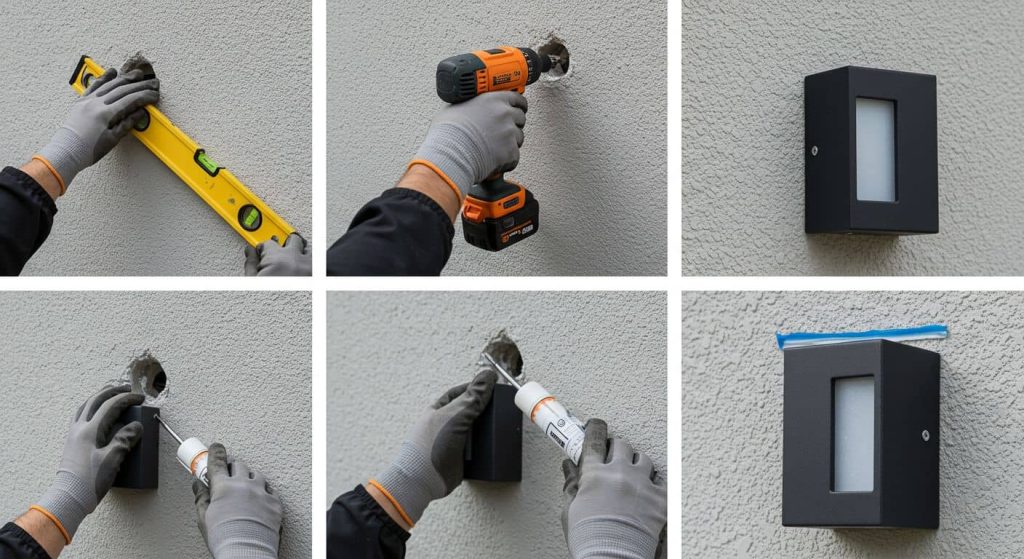
Step 1: Identify What You’re Mounting Into
The first step is knowing what’s behind your EIFS. This determines what type of anchor you’ll need.
- Mounting to substrate only: If your fixture is lightweight (under 5 pounds), you may be able to use anchors that secure to the substrate alone.
- Mounting to framing: Heavier items need to be anchored directly to the structural framing (studs) behind the EIFS.
- Using mounting blocks: For the most secure installation, especially for heavier items like awnings, mounting blocks installed during the initial EIFS application are ideal.
In existing homes without mounting blocks, you’ll need to locate studs. A stud finder won’t work reliably through EIFS, so you may need to determine stud locations from inside the house or by measuring from a known reference point like a window or door.
Step 2: Choose the Right Anchoring System
Several specialized anchoring systems are designed specifically for EIFS applications:
For Lightweight Items (Under 5 lbs):
- Wind-Devil 2 anchors: These are specially designed for EIFS and provide good holding power for lighter items
- EIFS anchors with toggles: These expand behind the substrate for better grip
- Foam board anchors: Designed to distribute weight across the foam insulation
For Medium-Weight Items (5-10 lbs):
- Casing bead terminations: Creating a proper termination in the EIFS with casing bead provides a solid mounting point
- EIFS specialty mounting hardware: Various manufacturers offer specialized hardware for medium-weight applications
For Heavy Items (Over 10 lbs):
- Through-bolting to framing: Bolts that extend through the EIFS into structural framing
- Engineered mounting systems: Systems designed by EIFS manufacturers for specific applications
- Retrofitted mounting blocks: Properly installed mounting blocks that distribute weight
Pro tip: Always use corrosion-resistant fasteners (stainless steel or hot-dipped galvanized) to prevent rust staining on your EIFS finish.
Step 3: Proper Sealing Techniques
Proper sealing is perhaps the most critical step. Even the best anchor will fail if water can get in around it.
- Use the right sealant: Always use an EIFS-compatible sealant – typically a high-quality elastomeric sealant designed for exterior use. Never use standard silicone caulk from the hardware store.
- Create a proper joint: For larger penetrations, create a properly tooled joint that allows for expansion and contraction.
- Apply sealant correctly: Apply a bead of sealant around the entire perimeter of the penetration, ensuring complete coverage without gaps.
- Consider flashing for larger items: For items like awnings, proper flashing details are essential. This might include kick-out flashing at the top of the awning to direct water away from the wall.
- Maintain proper joint proportions: The depth of the sealant joint should be approximately half the width for optimal performance.
Step 4: Professional Installation Considerations
While some simple mounting projects might be DIY-appropriate, many attachments to EIFS should be handled by professionals who understand the system’s intricacies.
- Consult manufacturer guidelines: Different EIFS manufacturers have specific recommendations for attachments
- Consider load-bearing capacity: A professional can assess whether your EIFS can support the weight of your planned attachment
- Electrical code compliance: For lighting fixtures, ensure all work meets local electrical codes
- Integrated solutions: For new construction or major renovations, consider integrated attachment points built into the EIFS system
Specific Mounting Solutions for Common Fixtures
Let’s look at some specific solutions for common items homeowners want to attach to their EIFS exteriors.
Exterior Lighting Fixtures
Lighting fixtures present unique challenges because they involve both attachment concerns and electrical considerations.
Best Practices for Light Fixture Mounting:
- Use mounting blocks: Pre-installed mounting blocks provide the most secure attachment point
- Plan for electrical connections: Ensure proper weatherproof boxes and connections
- Consider fixture weight: Choose appropriate anchors based on fixture weight
- Seal thoroughly: Use approved sealant around all penetrations
- Avoid uplighting mounted directly to EIFS: Consider ground-mounted options instead
Lighting Fixture Mounting Table:
| Fixture Type | Weight Range | Recommended Mounting Method | Special Considerations |
|---|---|---|---|
| Small sconces | 1-3 lbs | EIFS-specific anchors to substrate | Seal electrical penetrations carefully |
| Medium fixtures | 3-8 lbs | Anchors into framing or mounting block | May require additional waterproofing |
| Large fixtures/soffit lighting | 8+ lbs | Mounting block or structural attachment | Professional installation recommended |
| Address illumination | 1-2 lbs | EIFS-specific anchors | Low voltage options reduce penetration size |
Pro tip: For new construction, work with your electrician and EIFS installer to install electrical boxes and mounting blocks before the EIFS is applied. This creates a much cleaner, more secure installation.
Awnings and Canopies
Awnings present one of the biggest challenges for EIFS homes due to their weight and the forces they exert on mounting points.
Best Practices for Awning Mounting:
- Engineer the connection: Have a structural engineer or experienced contractor design the mounting system
- Mount to structure: Always mount through the EIFS into structural framing
- Use proper flashing: Install kick-out flashing at the top of the awning
- Create proper drainage: Ensure water has a path to drain away from the wall
- Distribute weight properly: Use sufficient mounting points to distribute weight evenly
Important note: For retractable awnings, the dynamic forces created during operation put additional stress on mounting points. These almost always require professional installation and possibly structural reinforcement.
Decorative Elements (Address Numbers, Plaques, Etc.)
Even small decorative elements can cause problems if not mounted correctly.
Best Practices for Decorative Element Mounting:
- Use standoffs: Mount items with standoffs that create a small gap between the item and the EIFS surface to allow for drainage
- Seal properly: Use appropriate sealant around all penetrations
- Choose lightweight materials: Opt for aluminum or composite materials rather than heavy stone or metal
- Consider adhesive options: For very lightweight items, EIFS-compatible adhesives might be an option
Security Cameras and Smart Home Devices
Modern homes often have multiple exterior-mounted electronic devices.
Best Practices for Electronic Device Mounting:
- Plan for wire management: Consider how cables will enter the home
- Use proper weatherproof boxes: For powered devices, use appropriate weatherproof electrical boxes
- Choose appropriate locations: Mount in protected areas like soffits when possible
- Consider wireless options: When available, wireless devices minimize the need for penetrations
Indiana-Specific Considerations for EIFS Attachments
Living in Indiana brings some unique challenges when it comes to mounting objects on EIFS exteriors.
Weather and Climate Factors
Indiana’s four-season climate creates specific stresses on EIFS systems and attachments:
- Freeze-thaw cycles: Our frequent freeze-thaw cycles mean that even tiny water penetrations can quickly become big problems. As water freezes, it expands, creating larger gaps that allow more water in when it thaws.
- Heavy rain and storms: Indiana’s sometimes intense rainfall can drive water into even the smallest openings. Proper flashing and sealing are essential.
- Temperature extremes: Our hot summers and cold winters cause expansion and contraction that can stress attachment points. Flexible sealants that accommodate movement are crucial.
- High humidity: Central Indiana’s humidity levels mean moisture management is critical in all building envelope details, including attachments.
Local Building Code Compliance
Different municipalities throughout Indiana may have specific requirements for exterior attachments, particularly for:
- Light pollution regulations: Many communities have restrictions on exterior lighting to minimize light pollution
- Electrical code requirements: Always ensure electrical installations meet local and state codes
- HOA and covenant restrictions: Many newer neighborhoods have specific guidelines about what can be attached to home exteriors
- Historic district requirements: Properties in historic districts may have special requirements for exterior modifications
Pro tip: Always check with your local building department before installing significant exterior fixtures, especially those requiring electrical connections.
Finding Indiana Contractors With EIFS Experience
Not all contractors understand the nuances of working with EIFS. Here’s how to find qualified help:
- Look for EIFS-specific experience: Ask about specific EIFS projects they’ve completed
- Check for EIFS manufacturer certifications: Many EIFS manufacturers certify contractors
- Request references for similar work: Ask to see examples of their mounting solutions
- Verify insurance: Ensure the contractor has proper insurance for EIFS work
At Indiana Wall Systems, we’ve spent 22 years specializing in EIFS installation and repair throughout central Indiana. Our team understands both the technical requirements of proper EIFS attachments and the specific challenges our Indiana climate presents.
DIY vs. Professional Installation: When to Call the Experts
While some homeowners are comfortable with DIY projects, EIFS attachments often warrant professional installation. Here’s a guide to help you decide:
Suitable for DIY (With Proper Research and Care):
- Lightweight address numbers using proper EIFS anchors
- Small decorative elements with appropriate mounting hardware
- Replacing fixtures on existing, properly-installed mounting blocks
- Holiday lighting clips that don’t penetrate the EIFS
Best Left to Professionals:
- Any electrical fixtures requiring new wiring
- Awnings, canopies, or heavy items that require structural attachment
- Security cameras or devices needing cable penetrations
- Anything requiring multiple penetrations of the EIFS system
- Attachments in high-water-exposure areas like near rooflines
The Cost Equation: DIY vs. Professional
When considering whether to DIY or hire a professional, remember this crucial equation:
DIY Cost = Materials + Tools + Your Time + Risk of Repair Costs
Professional Cost = Materials + Labor + Peace of Mind
That last factor – peace of mind – is often worth a lot when it comes to your home’s exterior. I’ve seen too many homeowners try to save a few hundred dollars on installation only to spend thousands on repairs after water damage occurs.
Case study: A client in Plainfield decided to install exterior lighting fixtures themselves to save about $400 on installation costs. They used improper anchors and sealing techniques. Two years later, they spent over $3,800 repairing water damage to their EIFS and the underlying wood structure.
Step-by-Step Guide: Installing a Light Fixture on EIFS
For those comfortable with DIY projects, here’s a detailed guide for installing a lightweight light fixture on an EIFS exterior. Remember, when in doubt, consult a professional!
Materials You’ll Need:
- EIFS-specific anchors appropriate for your fixture weight
- EIFS-compatible elastomeric sealant
- Drill with masonry bit
- Tape measure and pencil
- Level
- Caulking gun
- Weatherproof electrical box (if needed)
- Electrical tape and wire nuts (for electrical connections)
Step 1: Preparation
- Check local codes: Verify any permit requirements for electrical work
- Turn off power: If connecting to existing wiring, turn off power at the breaker
- Locate studs if needed: For heavier fixtures, determine stud locations
- Mark mounting locations: Use a level to ensure your fixture will be straight
Step 2: Creating Penetrations
- Drill pilot holes carefully through the EIFS using an appropriate bit
- Go slowly to avoid cracking or damaging the finish coat
- Measure depth needed for your specific anchors
Step 3: Installing Anchors
- Insert anchors according to manufacturer instructions
- Test for secure fit before mounting fixture
- Apply sealant around anchors before final tightening
Step 4: Electrical Connections (If Applicable)
- Install weatherproof box according to code requirements
- Make electrical connections following manufacturer guidelines
- Seal around electrical penetrations thoroughly
Step 5: Mounting the Fixture
- Apply sealant to the back edge of the fixture base
- Attach fixture to anchors, ensuring proper alignment
- Tighten securely but do not overtighten, which can crack EIFS
Step 6: Final Sealing
- Apply additional sealant around the entire perimeter of the fixture
- Tool the sealant joint for proper adhesion and appearance
- Inspect for complete coverage with no gaps
Step 7: Testing
- Turn power back on and test fixture operation
- Check for secure mounting by gently testing the fixture’s stability
- Plan for periodic inspection of the sealant condition
Important: This guide is for lightweight fixtures only. Heavier items require professional installation.
Maintenance and Inspection of EIFS Attachments
Proper maintenance of mounted fixtures is just as important as correct installation. Here’s how to ensure your attachments remain secure and watertight for years to come.
Recommended Inspection Schedule
| Attachment Type | Inspection Frequency | What to Look For |
|---|---|---|
| Light fixtures | Every 6 months | Cracked sealant, water staining, loose fixtures |
| Awnings | Twice yearly and after storms | Secure mounting points, flashing integrity, water stains on EIFS |
| Decorative elements | Annually | Secure attachment, sealant condition |
| Electronic devices | After severe weather | Water intrusion signs, secure mounting |
Signs of Trouble to Watch For
Be vigilant for these early warning signs of attachment problems:
- Staining or discoloration around mounting points
- Soft spots in the EIFS near attachments
- Cracked or missing sealant
- Rust streaks from fasteners
- Loose or sagging fixtures
- Bubbling or blistering in the finish coat near attachments
Sealant Maintenance
The sealant around your attachments is your first line of defense against water intrusion:
- Inspect regularly: Check for cracking, shrinking, or separation
- Replace when needed: Most exterior sealants need replacement every 5-10 years
- Clean before resealing: Always remove old sealant and clean surfaces before applying new sealant
- Use compatible products: Always use EIFS-compatible sealants for maintenance
When to Call a Professional for Inspection
Certain situations warrant a professional inspection of your EIFS attachments:
- After severe weather events like hail or high winds
- When selling your home (many home inspectors aren’t EIFS experts)
- If you notice any signs of water damage
- Before adding additional attachments to an existing EIFS wall
- If fixtures become loose or misaligned
At Indiana Wall Systems, we offer professional EIFS inspections that include evaluation of all attachments and penetrations. Early detection of problems can save thousands in repair costs.
Innovative Solutions for EIFS Attachments
The EIFS industry continues to evolve, with new products and techniques making attachments safer and more reliable. Here are some cutting-edge solutions worth considering:
Pre-Planned Attachment Points
For new construction or full EIFS replacement, planning attachment points before installation provides the best results:
- Integrated mounting blocks: Specially designed foam blocks installed during EIFS application
- Reinforced mesh areas: Extra layers of mesh at planned attachment points
- Built-in electrical boxes: Weatherproof boxes installed before EIFS application
New Hardware Solutions
Several manufacturers now offer specialized hardware designed specifically for EIFS applications:
- Two-stage anchoring systems: These distribute weight across both the substrate and foam
- Thermal-break anchors: Minimize thermal bridging while providing secure attachment
- Adjustable mounting systems: Allow for proper alignment without multiple penetrations
Adhesive Technologies
For some applications, new adhesive technologies eliminate the need for penetrations entirely:
- High-strength construction adhesives compatible with EIFS finishes
- VHB (Very High Bond) tapes for certain lightweight applications
- Specialized mounting pads that bond to the EIFS surface
Non-Penetrating Alternatives
Sometimes the best solution is one that doesn’t require penetrating the EIFS at all:
- Freestanding options: For items like lights, consider landscape lighting instead of wall-mounted options
- Soffit-mounted alternatives: Mount fixtures to soffits rather than EIFS walls when possible
- Rail-mounted systems: For items like planters, consider solutions that mount to railings or other structures
Pro tip: When building new or doing major renovations, have conversations about future attachment needs with your EIFS installer. Planning ahead can save significant headaches down the road.
Case Studies: Successful EIFS Attachments in Indiana Homes
Let’s look at some real-world examples of successful attachment solutions from our work across central Indiana.
Case Study #1: Carmel Home Exterior Lighting Retrofit
Challenge: A homeowner in Carmel wanted to add decorative sconces and security lighting to their 12-year-old EIFS home, but was concerned about water intrusion.
Solution: We created proper mounting points by:
- Carefully locating studs behind the EIFS
- Installing specialized EIFS fasteners that anchored directly to the framing
- Using proper flashing and sealing techniques around electrical penetrations
- Creating a maintenance plan for annual inspection of all attachment points
Result: Five years later, the lighting remains secure with no water issues. Annual inspections have identified minor sealant maintenance needed, which was addressed proactively before any damage occurred.
Case Study #2: Zionsville Custom Awning Installation
Challenge: A Zionsville client wanted to install a large retractable awning over their patio doors on an EIFS exterior wall.
Solution: We developed a comprehensive mounting strategy:
- Engineered attachment points that transferred load directly to the structural framing
- Created proper flashing details to direct water away from the wall
- Installed reinforced mounting plates to distribute weight
- Used specialized sealants designed for high-movement areas
Result: The awning has successfully weathered three years of Indiana seasons without any damage to the EIFS system or water intrusion issues.
Case Study #3: Fishers Smart Home Integration
Challenge: A tech-savvy homeowner in Fishers wanted to install multiple security cameras, smart lighting, and sensors on their EIFS exterior without compromising the system.
Solution: We created a comprehensive smart home exterior plan:
- Designated specific wiring pathways with proper penetration protection
- Installed mounting blocks for cameras at strategic locations
- Created a central entry point for low-voltage wiring
- Used wireless options where possible to minimize penetrations
Result: The home now features a fully integrated smart exterior with secure attachments and no compromise to the building envelope.
Conclusion: Protecting Your Investment While Enhancing Your Home
Adding lights, awnings, and other fixtures to your EIFS home doesn’t have to be a choice between aesthetics and protection. By understanding the unique requirements of synthetic stucco and following proper installation techniques, you can enhance your home’s appearance and functionality without compromising its weather resistance.
Remember these key principles:
- Respect the system: EIFS is an engineered cladding system, not just a decorative finish
- Distribute weight properly: Ensure loads are transferred to structural elements
- Seal thoroughly: Proper sealing is your primary defense against water intrusion
- Maintain regularly: Inspect and maintain attachments to prevent problems
- Consult professionals: When in doubt, work with contractors experienced in EIFS
At Indiana Wall Systems, we’ve spent over two decades helping homeowners throughout central Indiana properly maintain and enhance their EIFS homes. Whether you’re planning a new installation or need help correcting previous mounting issues, our team has the expertise to ensure your project succeeds without compromising your home’s exterior.
Next Steps for Indiana Homeowners
Ready to add new fixtures to your EIFS home? Here’s what to do next:
- Assess your project’s complexity: Determine if it’s suitable for DIY or requires professional help
- Research proper materials: Ensure you have EIFS-specific mounting hardware and sealants
- Check local requirements: Verify any permit or code requirements for your project
- Consider professional consultation: Even for DIY projects, an expert opinion can prevent costly mistakes
- Develop a maintenance plan: Schedule regular inspections of all attachments
Get Professional Help
For professional EIFS mounting solutions throughout central Indiana, contact Indiana Wall Systems at (765) 341-6020 or visit our website to schedule a consultation. Our experienced team serves Indianapolis, Carmel, Fishers, Zionsville, and surrounding communities with expert EIFS installation, repair, and attachment solutions.
Frequently Asked Questions
Can I mount anything to an EIFS exterior?
With proper techniques and hardware, most common fixtures can be safely mounted to EIFS. However, very heavy items may require special engineered solutions and professional installation.
How do I know if my home has EIFS or traditional stucco?
EIFS typically feels somewhat hollow when tapped and has more give than traditional stucco. It’s also typically smoother and more uniform in texture. If you’re unsure, a professional inspection can determine your exterior cladding type.
Will mounting fixtures void my EIFS warranty?
Improper mounting can potentially void warranties, but properly installed fixtures using approved methods typically won’t affect warranty coverage. Always check your specific warranty terms and consider professional installation for best results.
Can I use regular anchors from the hardware store for my EIFS?
Standard drywall or masonry anchors are not appropriate for EIFS applications. Always use anchoring systems specifically designed for EIFS installations.
How often should I reseal around mounted fixtures?
Most exterior sealants should be inspected annually and typically need replacement every 5-10 years, depending on exposure and the specific product used. Signs of cracking, shrinking, or separation indicate it’s time to reseal.
Is it ever safe to use adhesives instead of mechanical fasteners?
For very lightweight decorative items, EIFS-compatible adhesives can sometimes be used. However, for most fixtures, proper mechanical fastening is required for security and safety.
This article was written by Jeff Johnson, CEO of Indiana Wall Systems with over 22 years of experience in EIFS installation, inspection, and repair throughout central Indiana. For professional EIFS services, call (765) 341-6020.


